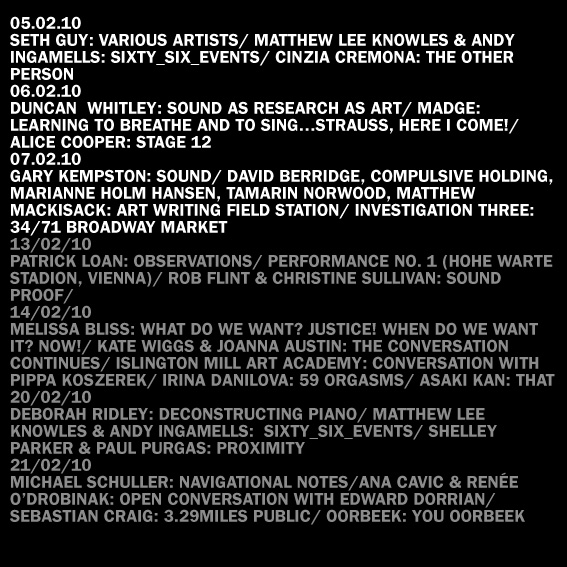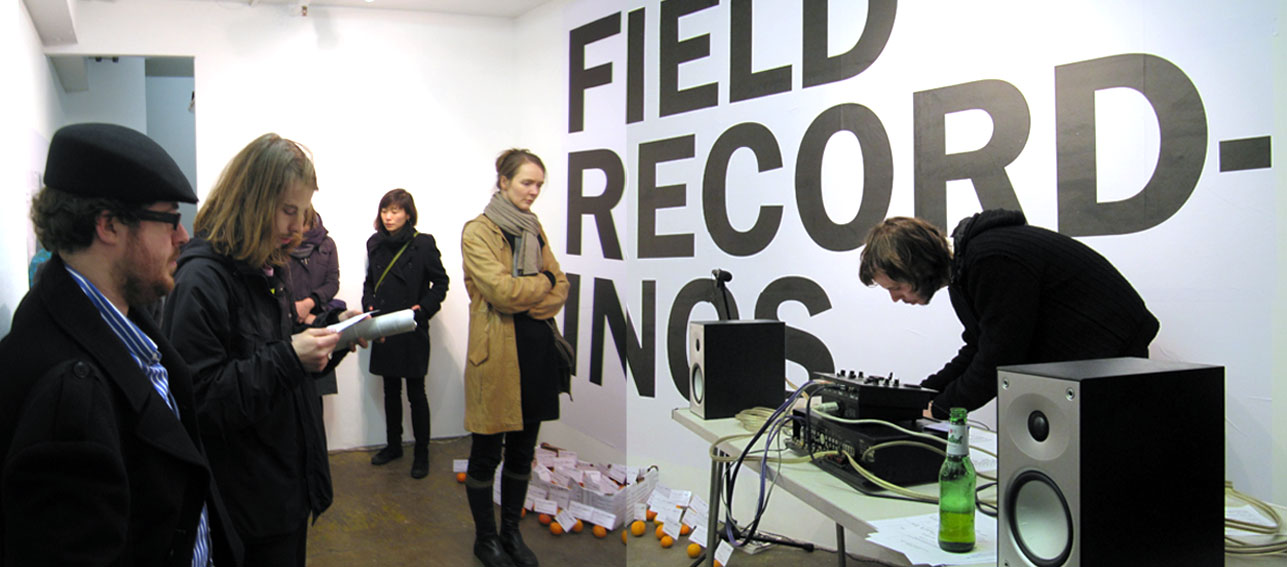
Utilizing 3 minute excerpts from over 50 field recordings of various artists exhibitions (including performance, video, sound and installation) between 2006 to the present, I propose to create a unique performance installation. Comprising of a simple setup of reclaimed amplifier, mixer, speakers and 2 minidisc players, 2 x 3 min excerpts will be played back simultaneously. For example, warhol mixed with kapoor. Excerpts will be selected randomly using each of the md’s shuffle function, but as each hybrid begins i shall announce the names of the artists for the benefit of the audience. Furthermore, as the entire session will be recorded live within the gallery this will essentially create a new 150 minute field recording.
A video projection with a small space in front of it.
“The concept of the Other Person as expression of a possible world in a perceptual field leads us to consider the components of this field for itself in a new way. No longer being either subject of the field or object in the field, the other person will become the condition under which not only subject and object are redistributed but also figure and ground, margins and center, moving object and reference point, transitive and substantial, length and depth. The Other Person is always perceived as an other, but in its concept it is the condition of all perception, for others and for ourselves.”
Gilles Deleuze, What is Philosophy
The Other Person shapes a gravitational and perceptual field creating concentric zones of intimacy and inviting shared vulnerability. The conversation with an image on the threshold between captured and performed activates and shapes a field of forces designed to flow towards a certain viewing position. But does the gallery space flow with opposing force-fields? Does the presence of other Others create counter-flows? Are further field recordings also diverting the movements of the Relationship.
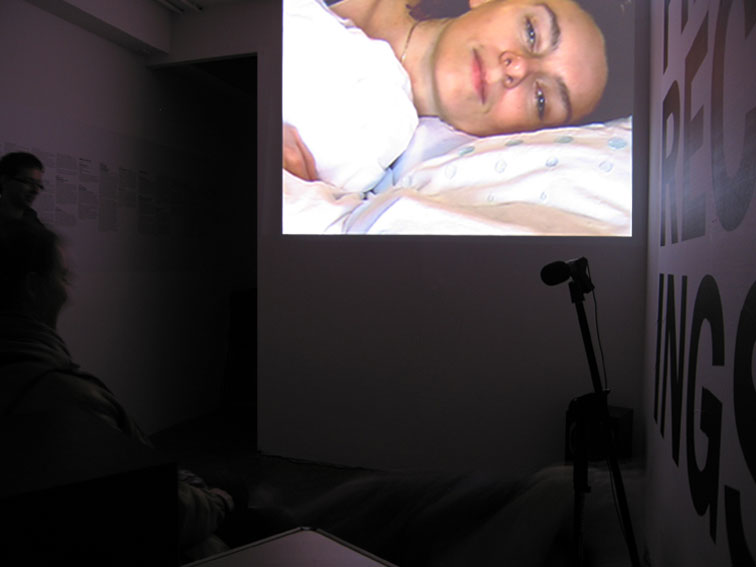
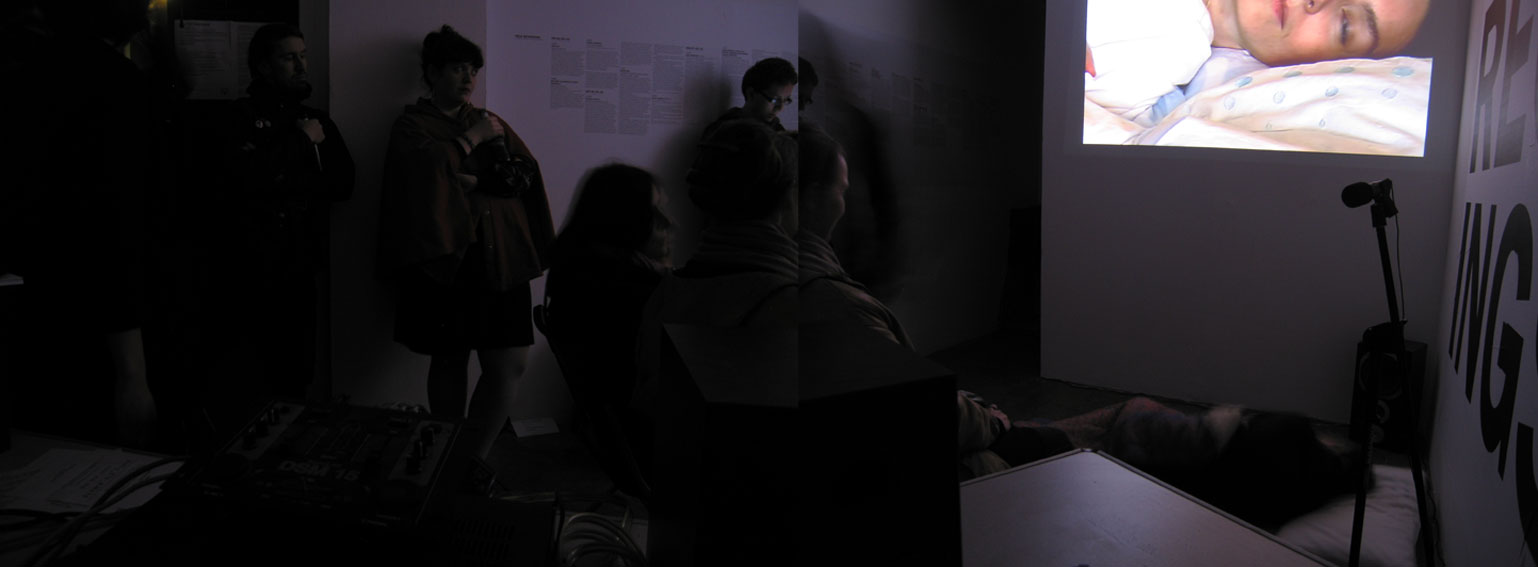
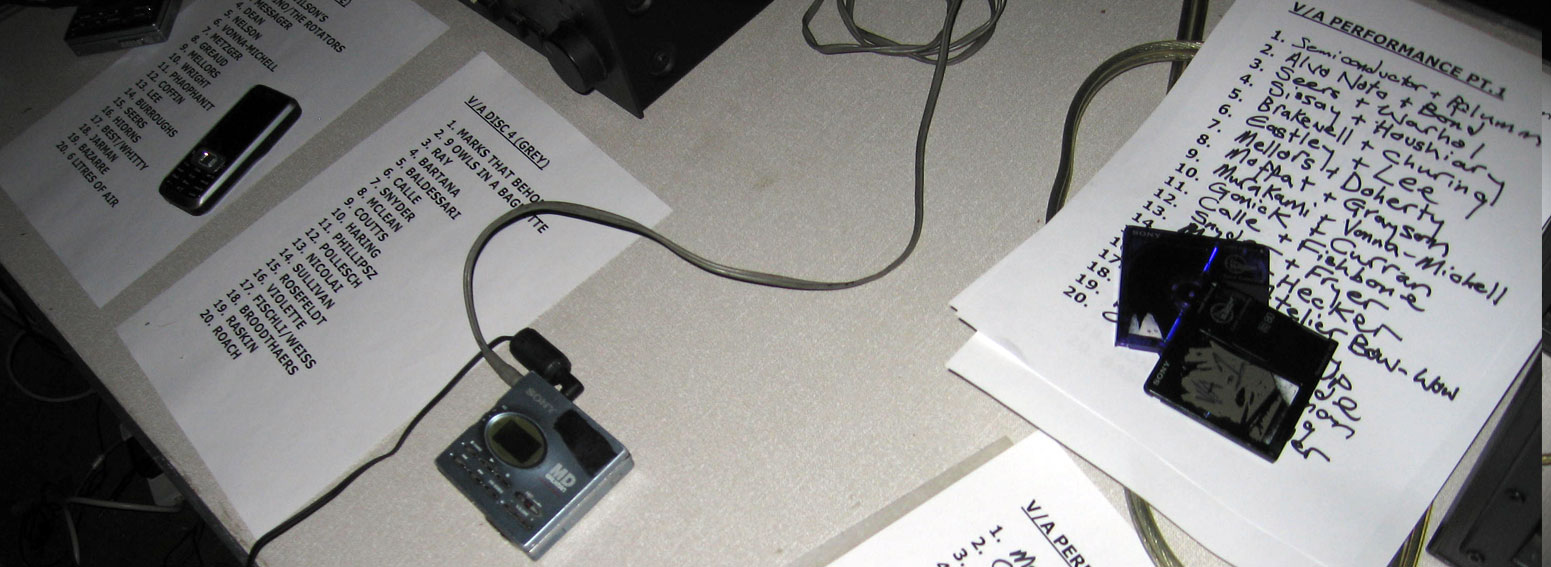
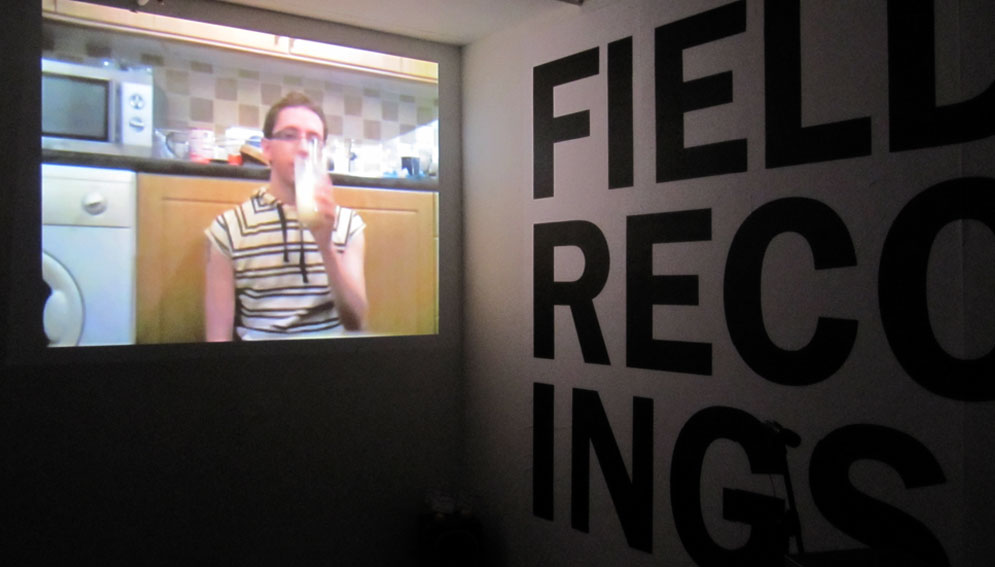
January 21st 2010 00:00 23:59
six_events in 2008 was performed by hundreds in 29 countries across the globe over 6 days
sixty_six_events was over a full 24 hour period and could be performed by anyone, anywhere. You were asked to Read. Respond. Relax. Repeat. And freely interpret and perform any number of the 66 events within the given time. Actions were documented and sent via twitter/facebook/myspace/youtube to info@sixtysixevents.com. For Field Recordings a presentation of the documentation by composers Matthew Lee Knowles & Andy Ingamells will be shown.
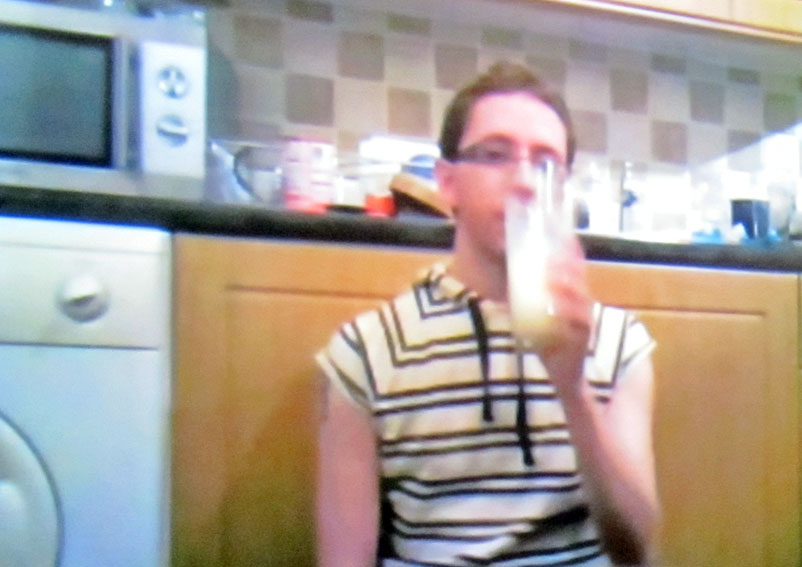
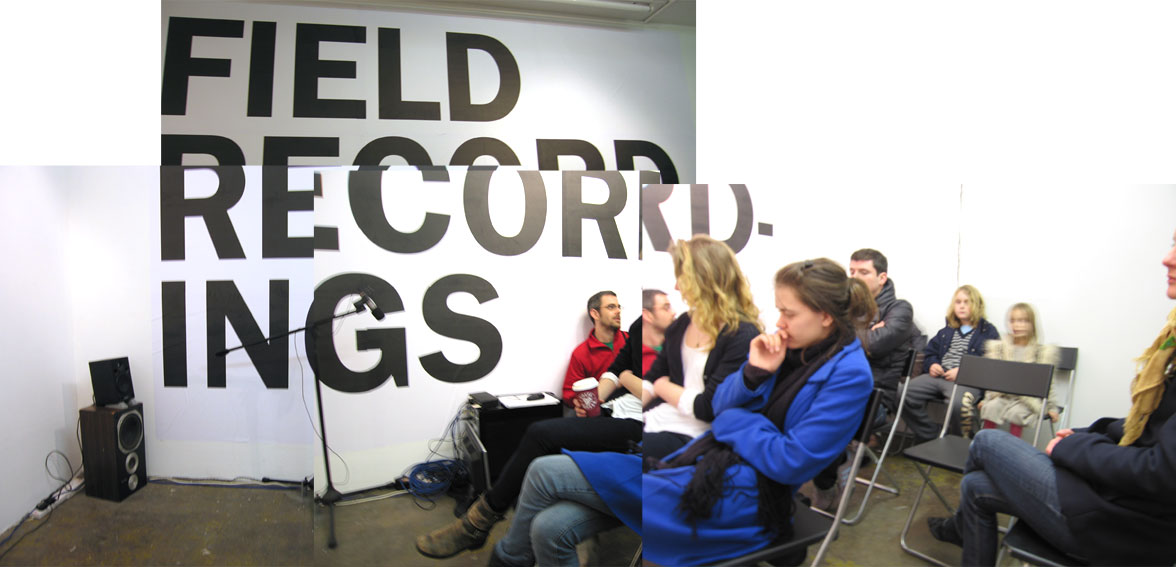
I’ve just returned from a recording session that was really interesting. I had the opportunity this evening to record a 120-piece brass band in rehearsal. I recorded pretty much the entire rehearsal. It’s a long story to cut short, but I first recorded this band in 2006 on the streets of Seville, at around 4am in the morning of Good Friday. It was a transformative experience. As part of a process of donating these recordings to the British Library (to the World and Traditional Music Dept., although my interests were more related to soundscape and sound & communication broadly, rather than the music) I managed to make contact with the band to ask them permission for the British Library to make these recordings accessible to the public. And now I’m here, having the fortune to record one of Seville’s most significant contemporary processional bands in rehearsal, conducted and directed by two of the bands conposers and arrangers, who were in fact the authors of the music I heard, and which affected me so much, back in 2006. I think, if you were to ask me to produce something for a slot at the gallery, it would be based somehow in this current work (maybe even this very recording I’m describing to you). And somehow the opportunity for me would be a working through, in some shape or form, of some of the shifting harmony and tension I find in this notion of the field


As a young singer aiming for the international Opera stage, one must have the ability to hold (sing) the perfect line. The beauty of the sustained musical line must not be broken up by a littering of unsightly, desperate breaths. Now, the training of the voice occurs largely in designated, private, practice rooms and with a specialist teacher or vocal coach. Any self-respecting young singer would not dare to display their vocal shortcomings, idiosyncratic personal mannerisms and delicate learning processes to the public.
Yet, this is what I propose to do.
The first part of the session will involve the singer simply ‘warming-up’ and testing their own personal boundaries in terms of executing a well sustained vocal line. The second part will include the expert input and fearless direction from a professional vocal coach. The recording of this session will need to be as covert as possible to allow the singer and their coach to feel as though they are in their typical, private practice room environment.
Field Recordings Proposal
The audience sits in a circle around a sound recording device. Each member is given a transcript of a conversation that was held at a previous Five Years event.
The audience are invited to read the transcript out loud. Each person takes it in turn to read a line of speech going around the circle.
After the transcript is read the remaining time is available to have a conversation. The conversation will be sound recorded and transcribed later.
The original participants in the conversation the transcript was taken from will be invited to this event.
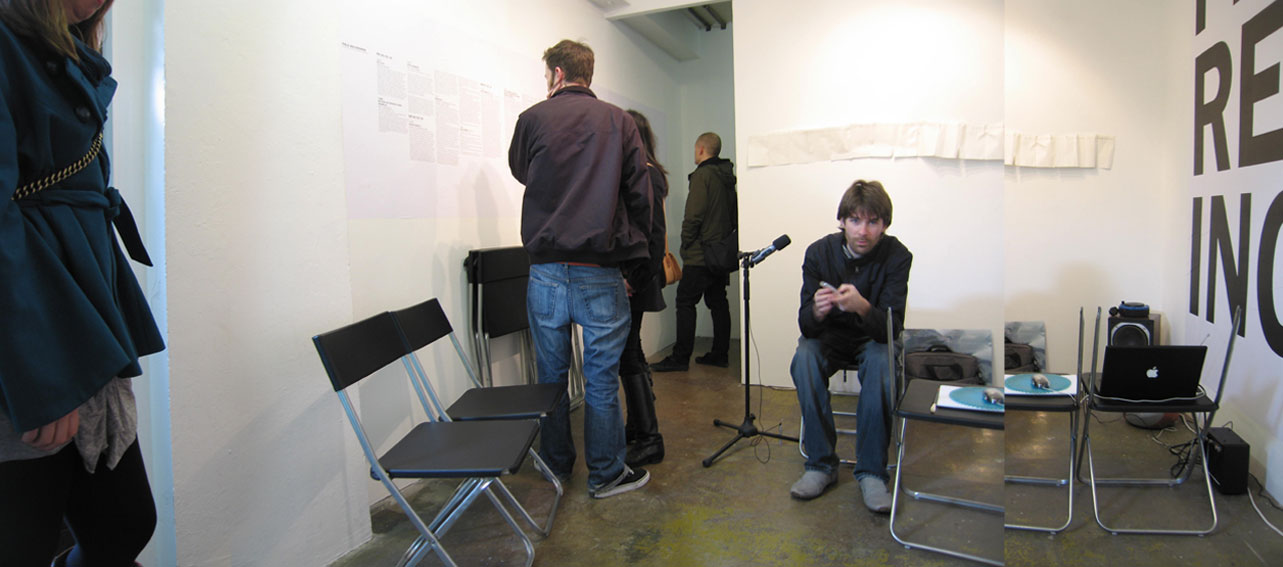


Robbie: To record in the field is to enter into a live space, one that is mostly unprepared, although the prepared may enter it in some form. This inevitably contains an element of the “document” and all the problems that come with this concept; how one enters into the space without unreasonably altering it, not forgetting that “one” is more often not native to the field.
Lucie: Sound resonates live throughout the field. Past struggles resonate within its present conscience. As a field study, with the conscience of the past and the sound of the present we listen, we capture and re-appropriate, in attempt to make a connection between these meta/physical fields and ourselves.
Rashmi: To look at the gallery as a field that is extendable to its immediate surroundings, opening it up. This process involves an awareness of the artist as a field in herself; bringing in what she hears, to be heard anew.
Investigation Three:
We speak into a microphone, words that were clear and concise become cluttered and we wonder what this could mean. What’s this got to do with field recording?
At which point the outside comes in…
On the surface speakers begin to tell a story of the immediate and recent present, but once scratched, you can hear the sound, or more accurately the non-sound, of what was. The ghost of another struggle in vain, played out in the name of local residents for local workers; now merely a poetic footnote in the gradual degradation of the community, to that of capital.
‘Noises have generally been thought of as indistinct, but this is not true.’ - Pierre Schaeffer
I intend to stage a series of exploratory sound pieces through the use of a portable studio comprising of one or two laptops, a small mini amplifier, a portable CD player and a few specially chosen noise-making props. I am interested in using your gallery space as part of the raw material for my work. Firstly, I will create a selection of pre-recorded electronic compositions that I feel will work well within my imagined idea of the space. (I have not visited the gallery up to this point). Then, once in the space I will use the physicality of the gallery as an instrument in itself. I will play the pre-recorded compositions through the CD player and at the same time evolve them by incorporating more computer generated sounds via the laptop. Found, naturally occurring sound from the day to day usage of the space, along with additional noises performed using the props (knocking on a wall, tapping the floor, moving a chair, bouncing a ball) at specific moments within the evolving compositions will be recorded on top of these existing elements. I am interested in the layering nature of the sound making and recording process and the ever abstracting spiraling form that the compositions could attain. This particular project is something I have been looking to perform for sometime and would work well within your Field Recording theme. My sound work consists of productions which explore the concept and perceptions of harmony and composition through a growing range of arrangements that incorporate fractured elements, diffuse atmospheres and inventive rhythms. The emphasis of my sonic practice is on originality and inventive sound creation. I experiment with the roles of noise-maker and arranger, and through these methods, I investigate the borderlines between accepted musicality and abstract sound design. Examples of my sound work can be found on pages 15 and 16 of my website: http://www.garykempston.com along with further information and my artist biography. I also co-run an independent music label: http://www.z-bop.co.uk
DAVID BERRIDGE, COMPULSIVE HOLDING, MARIANNE HOLM HANSEN, TAMARIN NORWOOD, MATTHEW MACKISACK: ART WRITING FIELD STATION
Histories of experimental poetics and writing are often related to practices and metaphors of “the field” - from Charles Olson’s “open field” poetics to engagements with anthropological field trips and field notes as models for situational and performative writing. The aim of this discussion for FIELD RECORDINGS is to try and explore how such ideas can inform current writing practices by offering an event that models the idea of “ a writer in the field” and also offers a “field recording” of such practices in operation.My proposal is to set up an ART WRITING FIELD STATION. This is a fictionalising of my current practice as a writer and researcher on the intersections of writing and arts practice. I have gathered together a variety of texts from different virtual and physical locations (galleries, bookstores, events, websites) that together constitute part of the ever shifting “field” of my writing practice. I find conceiving of this practice as “field” helps foreground such texts not as finished, consumable products but as active EVIDENCE and MATERIAL, something malleable to be worked with, examined, taken apart, noted, and annotated, and also part of a broader cultural (eco-) system. The event for FIELD RECORDINGS will be a structured group exploration of these materials, utilising a series of interventionist reading practices to explore the texts, the field of which they are part, and how they enter into our own practices. For example, I am interested in extracting from articles suggestive words and phrases which can then become a working lexicon and a structure for subsequent discussion. The field of art writing is, of course, comprised of people and relationships as well as texts, and I have asked several other writers/artists to supply materials and respond to particular bits of evidence. Other participants can come via yourself and an open call. A group of 6-10 is currently envisaged, but this is flexible.The intention is that the end result will be a field recording that is both an example and an exploration of the process by which the field of art writing consititutes itself. The session is also an attempt to propose and explore the nature and implications of adopting a “field” based methodology.Some of the books I am thinking about working with in this session are:
Dexter Sinister, Portable Document Format (New York, Lukas & Sternberg, 2009).
Graham Parker, Fair Use: Notes From Spam (London, Book Works, 2009).
Maria Fusco ed. The Happy Hypocrite, Issue 5, 2009.
Jacob Bee et al, Field Work (Edinburgh, A/S/N Mutual Press, 2009)
Céline Condorelli, Support Structures (New York, Sternberg Press, 2009)
Olivia Plender section in A Prior #19, Autumn 2009.
SHORT BIO: I live in London and make language works for galleries, performance, print and on line publications. Recent projects include two scripts for exhibitions: Guess Work Guest Work (7.9 Cubic Metres, Stanley Picker Gallery, London, 2009) and The Shadow of a Train (Totalkunst Gallery, Edinburgh, in June 2010). I curated Writing Exhibitions, a two day symposium of connections of writing and exhibition making in Nov 2009 and am currently writing a fiction based on a residency in Copenhagen during the COP15 climate change negotiations. Work online in Refutation, Soanyway, AXIS: Dialogue, RSA Arts & Ecology, Rubric and fillip.
